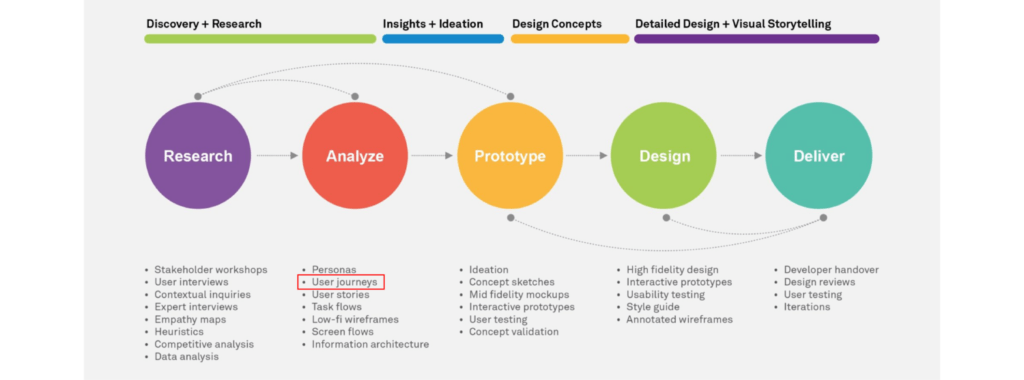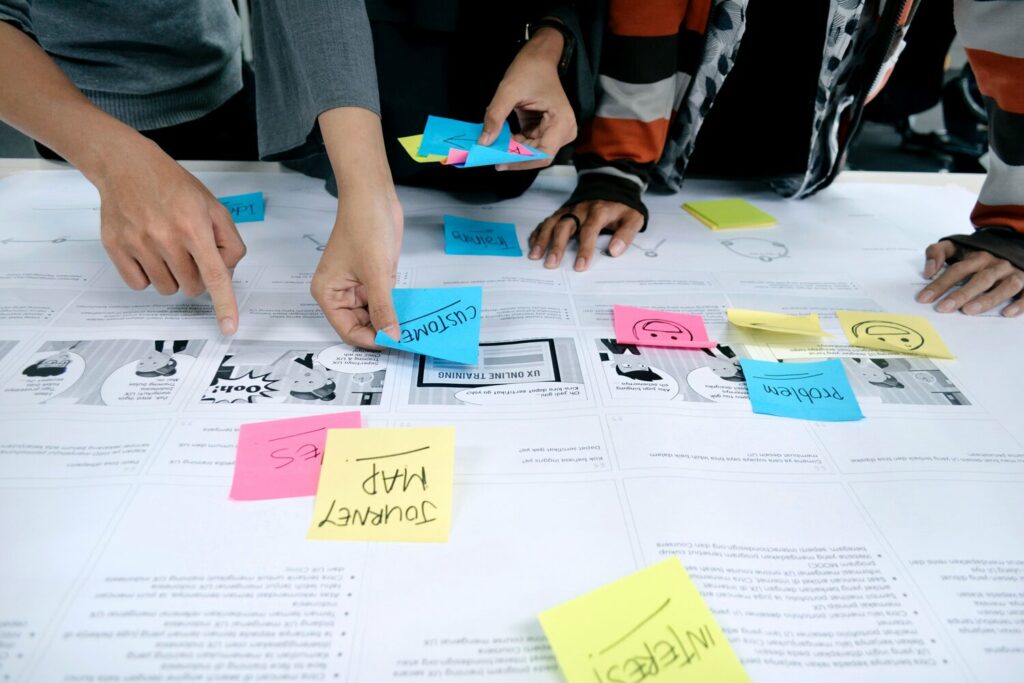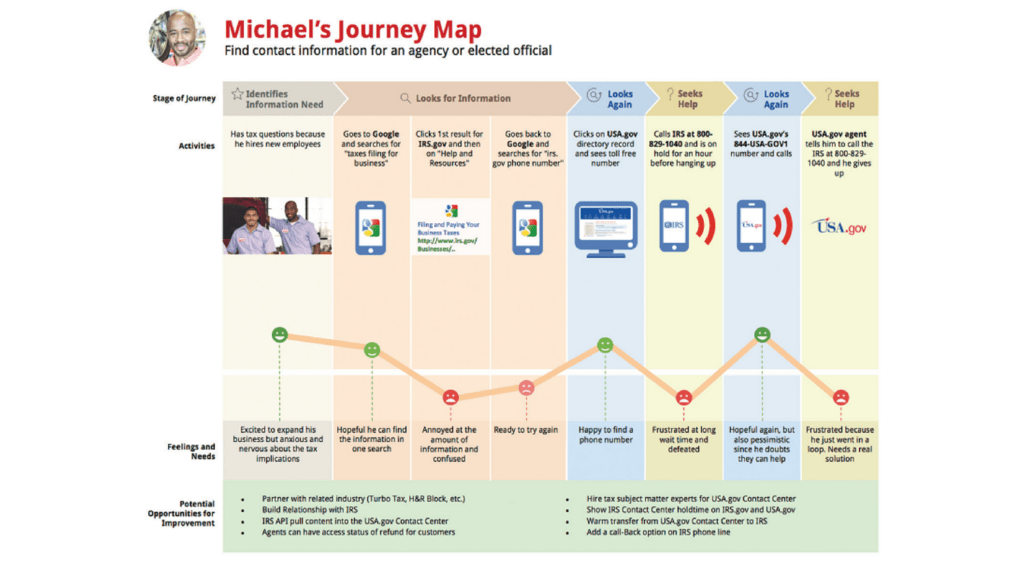Crafting UX user journey maps have proven to be a driving factor in acquiring and retaining customers to create brand loyalists. They are essentially research-based tools commonly used in UX design strategy to look at a user’s experience with a product or service over time, providing a clear overview of the many different factors and touchpoints involved. They map out the relationship between a user and product to gain an in-depth understanding of their experiences and pain points. Mapping your customer’s user experience journey is a key factor in creating good UX design and good user experience as it helps you better understand and empathise with your customers. The terms “customer journey map” and “user journey map” can be used interchangeably, as both represent a user or customer interacting with a product or service.

Source: lucidchart
Journey maps are designed as a set of user actions portrayed on a timeline. The timeline is further expanded upon to include the user’s thoughts and feelings corresponding to their actions to develop a narrative behind their actions.
Although there are no fixed methods to creating a journey map, most usually follow a similar format of identifying the user persona at the top, which includes a short description of who the users are and what their goals are. This is followed by different phases consisting of the steps the user takes to accomplish this goal, with their corresponding thoughts and emotions.

Source: wiprodigital
Journey mapping is regarded as one of the main UX design elements (as seen in the graphic above which lists out elements of UX Design) and is usually carried out at the “define” or “analyze” stage of the design thinking process using information obtained from the user research and persona developed earlier. The map will then be used in the ideation phase in helping designers brainstorm solutions.
Benefits of a customer journey map
A. Identify problems in advance
By placing themselves in their user’s shoes, designers are able to examine different tasks and questions on whether the design can successfully meet the user’s needs.
User mapping provides a clear layout on how users go about certain tasks and their interactions with different factors as they try to achieve their goals. This helps designers to better plan the flow and design of their product or service, resulting in a better user experience. It also helps designers to identify any potential problems or bottlenecks that may arise, allowing the design to be better optimized to meet the user’s expectations.

Photo by UX Indonesia on Unsplash
B. Save money and effort
Being able to identify a user’s pain points early in the design process allows designers to better plan around and adjust their design to address them. This prevents the situation where large problems are only discovered late in the development process where it can be costly and time-consuming to change.
C. Visual-based
Being a visual tool, a journey map can be used to effectively share and explain ideas with people of different teams such as developers, designers, or shareholders, etc. It is helpful for others to understand and read key pointers at a glance.

Photo by Christina @ wocintechchat.com on Unsplash
D. Accurate representation through data use
Crafted based on user research results and relevant persona, a user journey map provides an accurate representation of the user and their experiences.
E. Flexibility in usage
A strong point of using journey maps is its flexibility in its ability to fit in different situations and contexts. Many of its elements can be changed according to the situation. For example, designers can include a wider range of emotions (e.g. furious, frustrated, confused) rather than just the user’s overall mood going up or down. This can be further seen with the many journey map variations in the examples shown below.
How to create a user journey map
It is important for the user journey map to be detailed in showing important sub-tasks and events, along with the user’s thoughts and feelings through different situations. The map should include:
1. Persona
The journey map is based on the persona’s point of view in order to build a consistent narrative. Having a clearly identified persona ensures that the contents of the journey map are relevant to the brand and product.

People illustrations by Storyset
2. Scenario
The scenario talks about the specific situation in which the journey map serves to address. It is related to the user’s goals or needs. For example, if a user’s goal is to purchase a television online, the scenario would be of him browsing through the e-commerce platform to search through different sellers.
3. Phases
The timeline separates the key parts of the user’s journey into different phases according to different scenarios. For example, for a user purchasing an app online, the phases would be consideration, exploration, comparison, testing, evaluation.
Whereas for the introduction of new software to a team, the stages would be education, adoption, retention, expansion, advocacy. This is followed by touchpoints in each phase detailing a narrative of the user’s actions, thoughts, and feelings.

People illustrations by Storyset
User Journey Examples
Next, we will be talking about some good user journey examples and the differences between them.
1. Short write-up about the customer
The first example details a customer’s experience in purchasing a new car. This journey map includes the durations spanning over each phase. The customer’s general emotions are plotted as a single line across the phases. The line serves as a representation of the customer’s emotional “ups” and “down” across the different situations. What’s interesting about this map is the short write-up about the customer as well as a list of his expectations which give us context before we look at his journey map.

Source: nngroup
2. Potential improvement opportunities
The next example includes images to represent the different platforms used e.g. smartphone to computer. The map also includes a section for potential improvement opportunities at the bottom which can be useful during the ideation phase.

Source: UXBooth
3. Thoughts behind actions and pitfalls
Lastly, this example provides a comprehensive breakdown in each phase, by detailing specific emotions, touchpoints and opportunities. It goes into detail about what the user is thinking behind their actions as well as the opportunities and pitfalls presented for that scenario. Emotions are also listed specifically such as depressed, jealous and confident, providing more accurate context.

Source: masterdesignblog
3 Tips for a better user experience journey map
1. Create an empathy map
Empathy maps are design tools used to gain a deeper understanding of a user’s emotions and feelings. It is a simple visual that portrays a user’s behaviour and attitude toward a certain situation (e.g. what they think, do, feel, say, etc.). By analyzing the user’s emotional state, designers are able to better empathize with them, leading to journey maps that are more representative of what the users experience.

Source: UXbooth
2. Sketch the user journey
Compile all your details about the user’s journey (touchpoints, emotions, ideas etc.) and detail them in a step-by-step format by showing each interaction. Storyboarding can also help in visualisation through clear imagery and narrative. It is used to visually show what happens at each step.

Source: pinterest
3. List down every touchpoint
Touchpoints are all interactions or actions a user has with the product or service. Since a user may have many different interactions or actions throughout their user journey, it may be easier to list them down to avoid missing any out.
Conclusion
I hope that this article has provided you with some ideas into the importance of user journey maps and how to craft one. Journey mapping is a useful tool that can provide a comprehensive overview of a user’s frustrations and satisfaction in their interactions with the product or service. If done well, it can be used to come up with effective solutions to address the user’s pain points while capitalising on opportunities, resulting in a strong end-to-end user experience.
If you want to know more about user experience and its industry, do check out our other resources available on our website, such as our articles, weekly webinars, and podcasts. CuriousCore offers both a 2-day UX Design Course and a 4-month UX Career Accelerator for those keen on transitioning into the industry. Click the buttons below to find out more.
